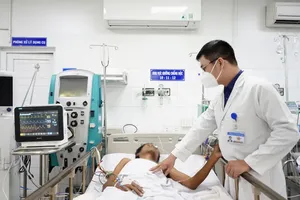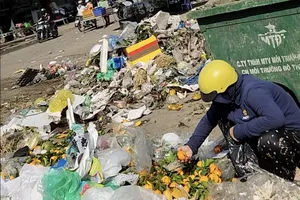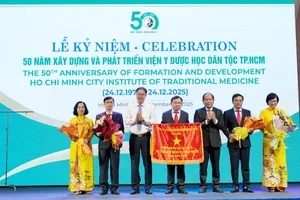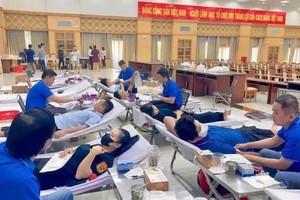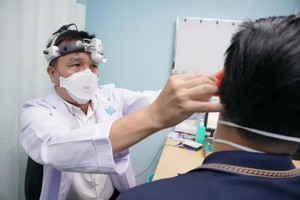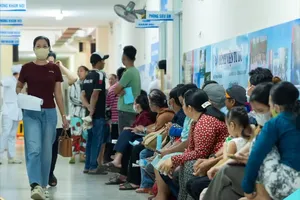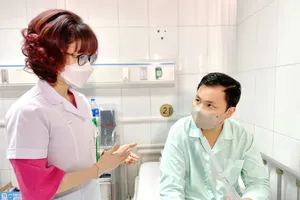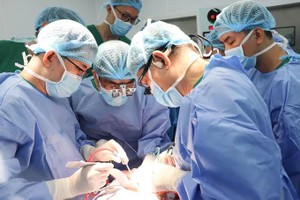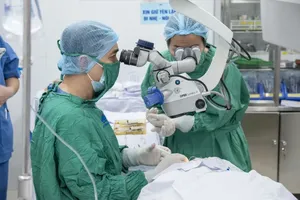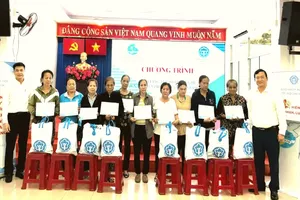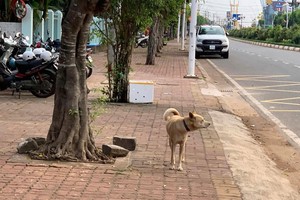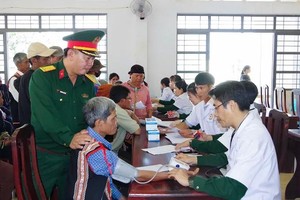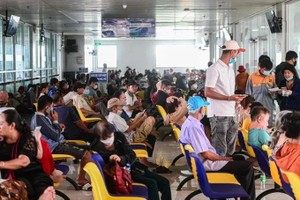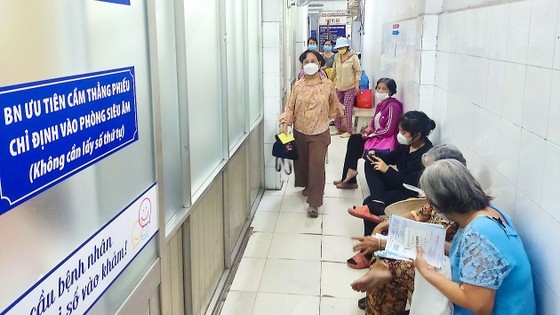 |
The corridors of Phu Nhuan District Hospital are narrow, less than one meter in width. |
Not only higher-level hospitals but numerous district-level hospitals in HCMC are also grappling on a daily basis to provide healthcare due to serious infrastructure degradation. Nevertheless, the renovation and expansion efforts encounter numerous challenges.
Commencement date delayed repeatedly
At 8 a.m. at Phu Nhuan District Hospital at 250 Nguyen Trong Tuyen Street, the parking lot was fully packed with vehicles of people who came to the hospital for medical check-ups. The examination rooms and inpatient areas measure around 13-15 square meters, but due to overcrowding, each room is forced to accommodate 3-4 beds. The hospital corridors are narrow, less than one meter in width. In some departments, the tiled floors are cracked, walls are peeling, and there are problems with mold. The most concerning issue is the complex electrical system, which poses a significant safety hazard in the event of a fire or explosion.
According to Specialist Level-2 Doctor Le Thi Kim Hanh, Deputy Director of Phu Nhuan District Hospital, this hospital was founded in 2007 with an area of 3,246 square meters, comprising one ground floor and two upper floors, by separating the Preventive Medicine Center. At present, the hospital’s 16 rooms and departments with 100 inpatient beds and 30 outpatient examination tables always experience overcrowding, alongside critical infrastructure deterioration.
In response to this situation, the Phu Nhuan District People's Committee decided to allocate a 993.8-square-meter plot of land at 128 Nguyen Trong Tuyen Street, formerly the location of Ngo May Middle School in Ward 8, Phu Nhuan District, for the construction of the second facility of Phu Nhuan District Hospital. This construction boasts a total floor area of 4,978 square meters and receives an investment of over VND92 billion from the city's budget. The project was approved by the HCMC People's Council with the execution duration from 2018 to 2020.
Nonetheless, constraints stemming from regulations allowing a maximum construction density of just 50 percent and mandating setbacks for construction ranging from 2 to 6 meters have limited the available construction space on this site to approximately 439 square meters. This falls short of meeting the one-way layout required by healthcare standards, where each medical department should occupy one floor. As a result, the design and construction of Phu Nhuan District Hospital's second facility at this location is deemed unviable.
On October 11, 2019, the Phu Nhuan District People's Committee sent an official dispatch to the HCMC People's Committee, proposing the discontinuation of the new construction project for the second facility of Phu Nhuan District Hospital at 128 Nguyen Trong Tuyen Street. They also recommended exploring the possibility of implementing a project at 140B Nguyen Van Troi Street. This property, managed by the HCMC House Trade Management Company Limited, was leased to SAVINA Company with an area of 1,870 square meters and a usable floor space of 3,443 square meters, which is not fully utilized and does not align with its intended purpose.
However, during interactions with the authorities, the process of transferring the site at 140B Nguyen Van Troi Street encountered complexity. Consequently, in April 2020, the Phu Nhuan District People's Committee proposed that the city proceed with the new construction project for the second facility of Phu Nhuan District Hospital at 128 Nguyen Trong Tuyen Street, requesting budget allocation for initial preparations, but it was not allocated fund at the time. Following several appeals and with proactive efforts to overcome these challenges by the city, the project for the new construction of Phu Nhuan District Hospital's second facility was ultimately approved. The implementation timeline was adjusted to between 2023 and 2025, with the total investment budget raised to over VND310 billion, including specialized healthcare equipment costs, and the total construction floor area increased from 4,978 square meters to 6,770 square meters.
"The project was originally scheduled to commence in the third quarter of 2023, but now there is information that it will be postponed to the first quarter of 2024. We, along with the patients, hope that the project's construction timeline will not be further delayed," said the representative of Phu Nhuan District Hospital.
Makeshift repairs
Despite several attempts to invest in repairs and construction, the leadership of Saigon General Hospital recognizes the significant challenges in renovating the 85-year-old hospital. They grapple with deciding what to repair and what to leave untouched. Plans for relocating the hospital date back to 2006, but after 17 years, no progress has been made. After multiple discussions, in 2017, departments and agencies recommended that the HCMC People's Committee proceed with a Build-Transfer (BT) contract project at the Ma Lang area in District 1 to build the hospital with a capacity of 300 beds. However, as of today, the project has not yet commenced, and the hospital's infrastructure continues to deteriorate significantly. In 2017, the city approved a renovation and repair project for the wastewater treatment system, with a total investment of VND32 billion, delegated to the HCMC Management Board of Industrial and Civil Engineering Construction and Investment Projects. Meanwhile, the construction of a new facility remains uncertain, with no specified start date.
Similarly, Le Van Thinh Hospital, located in Thu Duc City, also suffers severe deterioration and overcrowding, with a daily influx of 3,000-3,500 patients. Despite having received approval for a hospital expansion project on adjacent land, the project has yet to begin. Specialist Level-2 Doctor Tran Van Khanh, Deputy Director of Le Van Thinh Hospital, has expressed concerns about the deterioration of certain facilities, which have compromised the hospital's ability to provide medical care to local residents. Furthermore, the irregular funding sources for repairs are limited. Consequently, inpatient overcrowding is a recurring issue during peak periods. The hospital has adopted a range of temporary measures, including sending patients home when inpatient treatment is unnecessary, discharging patients with low surgical risks and minor underlying conditions, and arranging for medical staff to provide home care.
